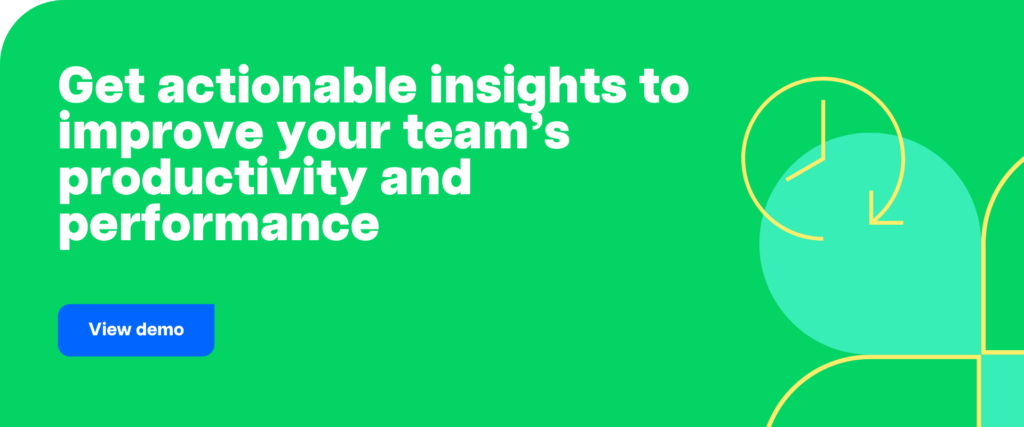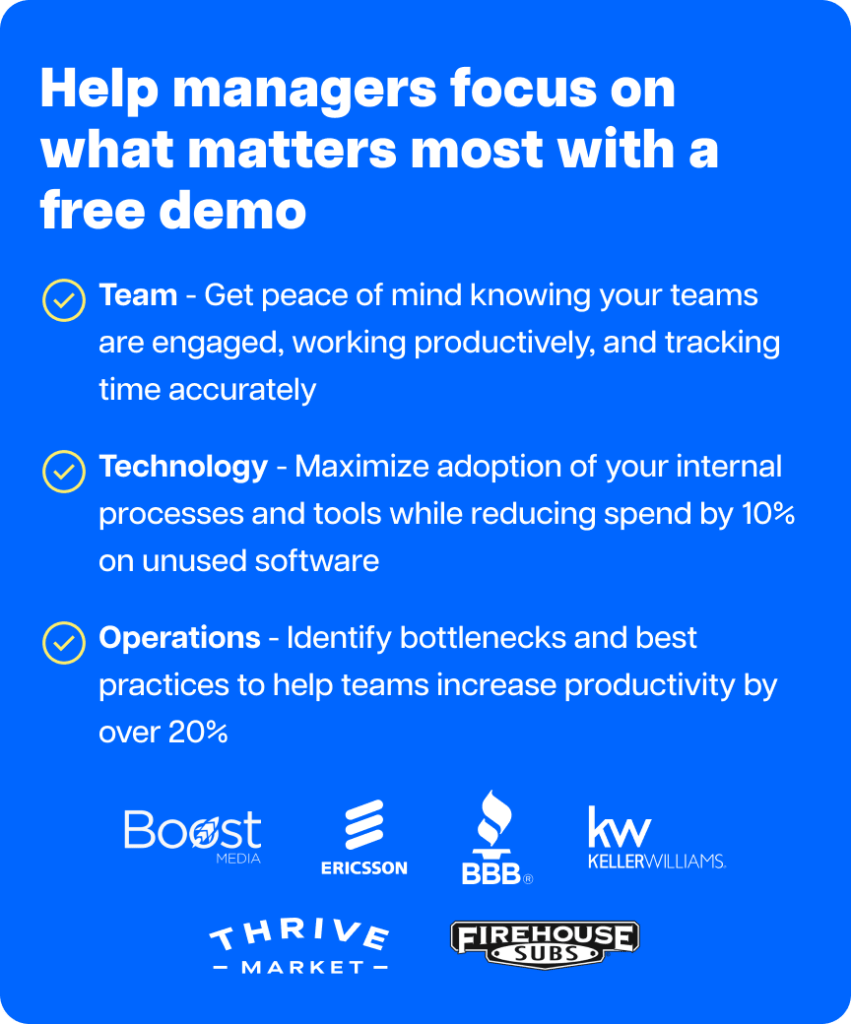You would be hard-pressed to find a team leader today who acknowledges being a micromanager.
But they’re out there and doing untold damage to morale, productivity and profit potential.
Micromanagement’s most immediate impact is on employee engagement levels. Feeling controlled, undervalued and unable to make decisions, employees withdraw or leave altogether.
But the influence goes far beyond disgruntled employees. The cost of micromanagement can be counted in:
- Decreased productivity
- Lower motivation to excel
- Less innovation and collaboration
- High employee turnover
Unfortunately, micromanagement isn’t a direct cost. It can’t be trimmed from a company’s budget or identified on invoices.
It’s a hidden cost that eats away at profits from the inside.
That means identifying and eliminating the cost of micromanagement requires a closer look at the conditions that enable it.

Table of Contents
- How to tell micromanagers from leaders who empower employee efficiency
- Seven (+1) tips for cultivating a culture of accountability
- Bonus tip: Avoiding micromanagement mistakes
- Take the next steps to establish accountability and boost employee efficiency
How to tell micromanagers from leaders who empower employee efficiency
Micromanagers intervene in every decision, speak over employees and leave no room for feedback. We all know the type.
This pattern of behavior tends to arise when there is a lack of trust between employees and team leaders.
Thankfully, the trust gap appears to be shrinking. Gallup’s latest data shows that employees’ trust in their leaders has risen steadily for the last 18 months, reaching 23% in late 2023.
However, declining employee engagement is counterbalancing rising trust. About half of US employees (47%) know what’s expected of them at work, and only 30% are happy with the communication they receive from managers.
This puts leaders in a tough position as they try to manage in a way that motivates employees and improves performance without tipping into micromanaging tendencies.
What’s emerging is a new leadership style based on empowerment through accountability. At its core, this approach is based on the understanding that employee efficiency isn’t motivated by the stick or the carrot but by a deeper and more complex sense of purpose.
Accountability is the answer – but there’s a catch
Accountability is a topic that divides opinions among employees, team leaders and top-level executives alike.
On one hand, the way accountability tends to be confused with a performance ‘scorecard’ creates a negativity bias. Instead of becoming an intrinsic motivator for employee efficiency, accountability becomes competitive and an external mandate.
On the other, employees are proven to be more engaged and effective when responsible for their own success.
Leaders who understand how to create a culture of positive accountability will see employee efficiency skyrocket, among other benefits:
- Increased motivation to excel: Clear goals and consistent feedback contribute to people feeling 3.2x more motivated to do outstanding work
- Lower costs and losses: Employee engagement leads to 28% less shrinkage (theft) and 41% fewer quality-related defects
- Enhanced innovation: When encouraged to contribute, employees are more likely to suggest innovations and cost-saving process improvements
- Higher productivity: Engaged, motivated employees are 18% more productive, contributing to 23% higher profits
- Improved employee retention: People want to work where they’re valued; employee engagement reduces absenteeism by 81% and turnover by 18-43%
In order to cultivate a culture of accountability and realize these benefits, leaders must transform how they give guidance, measure performance and provide feedback.
Accountability is not accounting. Responsibility is not employees fending for themselves. Empowerment is not an absence of employee efficiency.
With the right balance of clarity, trust and transparency, managers can avoid the profit-killing pitfalls of micromanagement and become a leader people look up to.
Seven (+1) tips for cultivating a culture of accountability
1. Set clear goals
Define a clear business strategy that highlights key growth initiatives and cascades down to individual goals.
Linking team and individual goals to needle-moving activities fosters a sense of purpose that has been shown to improve employee outcomes at work and at home.
2. Prioritize strategic tasks
The average employee spends 58% of their day on ‘work about work’, and 76% dedicate less than three hours per week to strategic tasks.
As well as being a significant time waster, mundane work is a motivation killer.
The trouble is that too many employees lack the visibility to identify strategic tasks and the decision-making power to focus their energy on them.
Effective managers create an environment where individual and team performance links to big-picture goals, and employees have the autonomy to prioritize work that moves the needle.
Non-strategic work is a significant – yet silent – profit-killer. Our latest guide, Unmasking Profit Killers: Demystifying hidden expenses for maximum revenue impact in 2024, dives deeper into this and other hidden costs, with practical strategies to eliminate them.

3. Recognize and reward excellence
Rewards and recognition are powerful motivators. Pay might not be.
According to Gallup, only 22% of employees – around one in five – felt that financial incentives motivated them to do what’s best for the organization.
Prioritizing individual success over team goals incubates a competitive culture that, somewhat ironically, hurts progress.
Effective leaders instead tie bonuses and incentive programs to team outcomes (which reflect strategic impact), fostering a collaborative and cooperative environment while tracking meaningful performance metrics.
4. Make it a habit
Accountability must be part of the organization’s DNA.
Discussing accountability regularly and providing tools like workforce analytics embeds responsibility into the cultural fabric.
Make accountability a regular conversation in the same vein as project updates. Tools like Time Doctor’s employee-friendly workforce analytics transform this process into a daily practice rather than an occasional check-in.
5. Give good feedback
Annual performance reviews cost anywhere from $2.4 million to $35 million annually for organizations with over 10,000 employees.
Meanwhile, employees who receive weekly feedback (instead of annual) are 2.7x more likely to be engaged at work and 3.2x more likely to be motivated to excel. They’re also more willing to offer constructive input, and more trusting of management.
So it’s worrying that only 22% of employees receive weekly feedback, although employees’ perceptions of having an open, trusting environment are rising again after plateauing during the pandemic years.
Transitioning from annual top-down performance reviews to more frequent, less formal, and more data-driven feedback reduces people management costs and has proven benefits for employee engagement and efficiency.
6. Utilize technology for improved performance and accountability
Good decisions are made with good data. Using workforce analytics to gather, analyze and activate performance data is a win-win for modern organizations.
Team leaders gain peace of mind that the right work is being done without needing to constantly supervise (read: micromanage) employees.
Employees gain tools to self-manage performance and productivity, encouraging them to be accountable for their time.
Executives get deeper insights into the factors contributing to organizational growth, helping them make better decisions and plan long-term.
Workforce analytics provides transparent, reliable, real-time data that levels the playing field and eliminates the negativity bias that can creep into scorecard-style accountability.
From there, team leaders can explore the potential of AI and automation to further enhance employee efficiency by streamlining time-consuming ‘work about work’.
7. Measure progress
Tools and systems that track progress toward goals enable employees and managers to stay aligned, even when they’re not working in the same space.
Regular check-ins are a good start to ensure everyone is accountable, on track and asking for help to overcome challenges.
Increasingly, workforce analytics is becoming an indispensable support for check-ins.
Having reliable data helps employees plan their work effectively to stay ahead of deadlines, and gives managers visibility over how people spend their time without needing to hover over employees’ shoulders.
Bonus tip: Avoiding micromanagement mistakes
8. Lead by example
Team leaders and line managers, we’re talking to you directly now.
Modeling the behavior you expect from employees sets a positive precedent. In particular, it shows your team that you’ve got their back.
Accountability in the workforce doesn’t mean abdicating responsibility when things get tough. It means giving over a measured amount of control in the form of autonomy over scheduling, task prioritization and productivity, while maintaining a position of guidance and visibility.
Get the balance right and you’ll see employee efficiency soar.
Here are a few behaviors to focus on to transform from profit-killing micromanagement to productive accountability:
- Share information transparently and keep everyone informed
- Focus on coaching and development, not control
- Trust your employees to make decisions and solve problems autonomously
- Celebrate successes and support challenges, don’t seek out mistakes
- Delegate tasks based on skills and strengths, and empower self-direction
- Encourage open communication and feedback, replacing fear with trust
- Provide regular, constructive feedback and ask to receive it
Take the next steps to establish accountability and boost employee efficiency
A culture of accountability is built on trust, empowerment and clear expectations.
One vital ingredient that distinguishes micromanagement from accountability is workforce analytics.
Workforce analytics provides transparency to remove bias from decision-making, gives employees tools to self-manage performance, and enables close measurement to keep everyone on track toward strategic growth.
Time Doctor, the leading employee-friendly workforce analytics platform, empowers modern teams with reliable, real-time data and work-life balance monitoring.
With a wide range of collaborative features and over 60 platform integrations, Time Doctor builds trust, transparency and accountability, leaving no room for micromanagement.
Try out the free Time Doctor demo to find out how it can help your business!

Carlo Borja is the Content Marketing Manager of Time Doctor, a workforce analytics software for distributed teams. He is a remote work advocate, a father and a coffee junkie.


